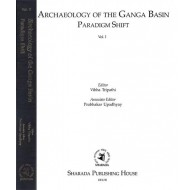
Archaeology of the Ganga Basin Paradigm Shift (Set of 2 Volumes)
More Information
| ISBN 13 | 9788188934652 |
| Book Language | English |
| Binding | Hardcover |
| Author | Vibha Tripathi |
| Editor | 2010 |
| Category | Books |
| Weight | 2,520.00 g |
Frequently Bought Together

This Item: Archaeology of the Ganga Basin Paradigm Shift (Set...
₹4,837.00
Sold by: Swadhyayam
ADD TO CART

This Item: Archaeology of the Ganga Basin Paradigm Shift (Set of 2 Volumes)
Sold By: Swadhyayam
₹4,837.00
Vishva Mein Islaam: Political Islamic vichaardhaara kee sameeksha 1
Sold By: Garuda Prakashan
₹339.00
The Original Lynch Mob: The Untold Stories of Political Violence in West Bengal
Sold By: Garuda Prakashan
₹339.00
Total Price : ₹4,837.00
Product Details
Archaeology of the Ganga Plain has come long way since the pre-independence days. The "Buddhist sites' had attracted the attention of doyens of Indian archaeology of the British period. Important sites mentioned in literature were located. Many were excavated. Monastic settlements lying buried saw the light of the day. Subsequently, a fresh paradigm to archaeological investigations was introduced by Wheeler. He not only brought in scientific excavation techniques to be adopted in 'archaeology from the earth, he laid great emphasis on stratigraphy and relative chronology. He equally emphasized on methodical recording of facts and finds. Wheeler, writing the foreword to Personality of India by B. Subbarao (1958: viii) wrote, "The first stage is one of limited knowledge and restricted inference (often wrong). Upon this follows the accumulation of scraps of evidence which tend to constitute an untidy and incoherent heap only later, when this 'heap' has sufficiently grown and matured, does it begin to take an assured place in the landscape. Since Wheeler's time not only the 'heap' has grown but the landscape has also expanded. Talking in the specific context of the archaeology of Ganga Plain, it has come a long way with extensive explorations and excavations going on regularly over the decades. Within the area, in depth explorations have been conducted on selected river valleys, and district-wise village to village surveys A few horizontal excavations have also been conducted providing a clearer picture of ancient cultures. However, new models of understanding cultures with processual and post processual archaeology have placed greater challenges before investigators. In light of these new conceptual frameworks, the excavations need to be re-planned and research schemes re-oriented. With new ideas and theories the role of scientifically discovered material and their interpretation assume greater significance today. The term "paradigm" in such context was first used by Thomas S. Kuhn in The Structures of Scientific Revolutions (1962 & 1970. University of Chicago Press Chicago & Lendon). This term has gained momentum and wider ramifications since ther. In the present context our concern is a review and re-examination of material remains with fresh angle Our emphasis should now be on a more holistic reconstruction of cultures using multi-pronged approach. The archaeology of the Ganga Plain has undergone changes over last few decades. The so called Dark Age is not dark any more. We have a clear idea of cultural sequence. The gaps that existed between different cultural periods are now nearly filled up. An example in the case is the hiatus between Harappan and the succeeding PGW culture in the Indo-Gangetic Divide. We have now come across a late-Harappan-PGW overlap in the Saraswati-Yamuna basin in Punjab Haryana The Harappan and OCP/Copper-Hoard interaction is an evidence of intrusion of (late) Harappans in the Yamuna-Hindon Doab with rich jewellery at Mandi and having extensive cemetery at Sanauli. We need to work out a new paradigm for study of these cultural phases The gap between Stone Age and metal using cultures is consistently narrowing down with new researches. The Neolithic-Early farming cultures are yielding dates that push back the beginning of agriculture in the Ganga Plain to 7th-6th millennium BC. Iron appears in the region in a Chalcolithic milieu. The "C dates take back antiquity of iron in the Ganga Plain to the early pan of the second millennium BC. This calls for a review of three Age classification of cultural evolution in human history. Urbanization of the Ganga Plain and NBIW culture has been almost synonymous. Use of baked bricks, changes in architectural scheme showing certain level of sophistication, introduction of script, coinage, craft specialization, trade-commerce and growing inter-regional communication are closely associated with NBPW culture. The antiquity of the culture is consistently being pushed back. We have got a number of carbon fourteen dates for NBPW period ranging between 1200-900 BC. These dates, if corroborated further from more sites should have a strong bearing on cultural scenario. It is high time that beginning of urbanization in the Ganga Plain is viewed in light of such early evidence. These facets of the archaeology of the Ganga Plain call for a paradigm shift in approach to study of material remains coming forth from sites of the region. New models and approaches are called for to reconstruct the personality of cultures of the Ganga Plain. It is with application of a holistic approach that we can re-write the history of Ganga Plain termed by Mortimer Wheeler as the 'Ganges Civilization in the late fifties. Though the term 'civilization' appeared inapt at that time but it proves almost prophetic. It was on the foundation of smaller settlements having Neolithic-Chalcolithic antecedents that the Janapadas of the early literature assumed the shape of Mahajanapadas on which rests the edifice of Imperial dynasty of Magadh that united the subcontinent into a Nation". Language, literature, art, craft, technology, trade-commerce, international diplomacy-all achieved great heights. But the process took several centuries. How did it happen? Through what kind of stages did it go through? We need to seek answer through study of the past in a more systematic way by adopting fresh approaches.




















